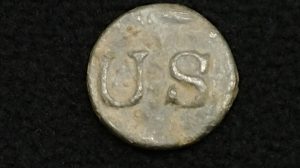
Sometimes a little deception is all you need to win the day. I found this little beauty in October this year in upstate New York. I found it with my Teknetics T2 Metal Detector in a field near the area of the battle of Plattsburgh during the War of 1812. It’s a pewter US Soldier Cuff Button and it’s in great shape. I made a video of my trip to this area and included the following description describing the history and I discovered a great story of how the commander of the US forces in the area outsmarted the British with a little deception. Link is below to the video if interested.
The Hunt:
We had done our research on the area we were hunting and found that there was once a small little village in a field next to the Little Chazy river, called Factoryville. The locals all refer to it as “Suckertown”. There was no longer any signs of this town but using a metal detector, we were sure we could find it. We wondered what kind of metal detecting finds would come up from the Suckertown area. This town had multiple buildings, and multiple mill sites. It didn’t take us long to locate the old road and locations of the old buildings. The hunt was on.
The History
One of the main historic events that happened close to this area was the Battle of Plattsburgh in 1814 between the British and the US. This battle is credited as one of the final battles the lead to the end of the War of 1812. The British HQ, where the commander and over 10,000 British troops camped was only about 10 miles away from these fields we were hunting in Chazy, NY at The Scott House.
In the second year of the War of 1812, a fleet of British ships sailed to attack the port town of Plattsburgh on Lake Champlain, while a coordinated land attack came from the North out of Canada and marched South towards Plattsburgh. The land attack was met with many skirmishes from an under-manned US Army in the region that had elicited the help of any able bodied man in the area to take up arms. In a brilliant move, the commander of US forces who were concealed in the wood line but whose supply road was in site of the British, took small groups of soldiers and marched them out of the woods, out of site, down the supply road, then back into the woods creating the illusion that our forces were constantly being reinforced by many more soldiers and supplies than we really had. When the Navy battle started, it roared through the area and the commander of British land forces hearing the battle was underway, chose to allow his soldiers to finish breakfast before taking up arms and getting into marching formations. The Navy battle was over in a short amount of time resulting in the British ships being defeated by a much smaller fleet of US ships. Seeing this defeat which was not supposed to happen, and also knowing the the US had been “reinforcing” their numbers for days, it was clear to the British commander that this was a lost cause so he made the decision to retreat back up into Canada and abandoned his attack plan on Plattsburgh. A few months later, a treaty was signed ending the War of 1812.
The Wonder
In my video you see that I find this War of 1812 pewter US Soldier Cuff Button in the fields adjacent to Suckertown. How did that get there? Did it belong to one of the soldiers that turned back the British Army during that battle? Was this the site of one of the many skirmishes? These are the questions that get our minds turning and excite us as Metal Detectorists. I am so excited to have brought something home that ties to that period of time and in that area knowing what happened there. A very special find indeed for a guy from Colorado.

